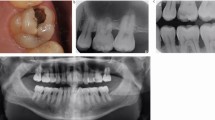Abstract
Data sources
Cochrane Oral Health Group's Trials Register, CENTRAL, Medline via OVID, EMBASE via OVID; no restrictions on language or date of publication.
Study selection
Parallel group and split mouth randomised and quasi-randomised controlled trials comparing stepwise, partial and no dentinal caries removal with complete caries removal in unrestored primary and permanent teeth were included in this review.
Data extraction and synthesis
Title and abstract screening was by two reviewers, with disagreements resolved by a third. Full texts of eligible studies were assessed by the team until consensus, and data extraction was by three reviewers independently and in triplicate. Two reviewers assessed risk of bias. Trial authors were contacted where possible.
Results
Eight trials (all assessed as high risk of bias) with 934 participants and 1372 teeth were included in this updated review (Previously complete or ultraconservative removal of decayed tissue in unfilled teeth, Ricketts, 2006) with four new trials being included. There were a number of different comparisons in the trials (stepwise or partial or no dentinal caries removal compared to complete caries removal) with one study including more than one of these comparisons. Four studies investigated primary teeth, three permanent teeth and one included both.
For stepwise caries removal, (four studies), there was a 56% reduction in incidence of pulp exposure (RR 0.44, 95% CI 0.33 to 0.60, P < 0.00001) compared to complete caries removal. The mean pulp exposure incidence was 34.7% in the complete caries removal group and 15.4% in the stepwise groups. There was no difference in signs and symptoms of pulp disease (RR 0.78, 95% CI 0.39 to 1.58, P = 0.50).
In the two partial caries removal studies, the incidence of pulp exposure reduction was 77% for the partial caries removal group (RR 0.23, 95% CI 0.08 to 0.69, P = 0.009) with a mean pulp exposure incidence of 21.9% in the complete caries removal groups and 5% in the partial caries removal groups. There was insufficient evidence to determine whether or not there was a difference in signs and symptoms of pulp disease (RR 0.27, 95% CI 0.05 to 1.60, P = 0.15), or restoration failure (one study showing no difference and another study showing no failures in either group).
There were two very different studies which looked at no dentinal caries removal compared to complete caries removal. There was some evidence of no difference between these techniques for the outcome of signs and symptoms of pulp disease and reduced risk of restoration failure, favouring no dentinal caries removal, from one study. There were no instances of pulp disease or restoration failure in either group from the second study. Meta-analysis of these two studies was not carried out because of the substantial clinical differences between the studies.
Conclusions
For management of dentinal caries, both stepwise and partial excavation showed clinical advantage over complete caries removal by reducing the incidence of pulp exposure in symptomless, vital, carious primary as well as permanent teeth. The review found no difference in signs or symptoms of pulpal disease between stepwise excavation and complete caries removal.
There was insufficient evidence to determine whether there was a difference in signs and symptoms of pulp disease or a difference in the risk of restoration failure with partial caries removal.
For the two no dentinal caries removal studies, the one investigating permanent teeth found no difference in restoration failure and the one investigating primary teeth found a statistically significant difference in restoration failure favouring the intervention.
Due to the short term follow-up, low reporting of patient centred outcomes and high risk of bias, further high quality, long-term clinical trials are still required to assess the most effective intervention.
Similar content being viewed by others
Log in or create a free account to read this content
Gain free access to this article, as well as selected content from this journal and more on nature.com
or
References
Massler M . Pulpal reactions to dental caries. Int Dent J 1967; 17: 441–460.
Fusayama T . The process and results of revolution in dental caries treatment. Int Dent J 1997; 47: 157–166.
Alves LS, Fontanella V, Damo AC, Ferreira de Oliveira E, Maltz M . Qualitative and quantitative radiographic assessment of sealed carious dentin: a 10-year prospective study. Oral Surg Oral Med Oral Pathol Oral Radiol Endod 2010; 109: 135–141.
Peters MC, Bresciani E, Barata TJ, et al. In vivo dentin remineralization by calcium-phosphate cement. J Dent Res 2010; 89: 286–291.
Thompson V, Craig RG, Curro FA, Green WS, Ship JA . Treatment of deep carious lesions by complete excavation or partial removal: a critical review. J Am Dent Assoc 2008; 139: 705–712.
Miyashita H, Worthington HV, Qualtrough A, Plasschaert A . Pulp management for caries in adults: maintaining pulp vitality. Cochrane Database Syst Rev 2007; 18: CD004484. DOI: 10.1002/14651858.CD004484
Aguilar P, Linsuwanont P . Vital pulp therapy in vital permanent teeth with cariously exposed pulp: a systematic review. J Endod 2011; 37: 581–587.
Ricketts D, Kidd E, Innes NPT, Clarkson JE . Complete or ultraconservative removal of decayed tissue in unfilled teeth. Cochrane Database Syst Rev 2006; 3: Art. No.: CD003808. DOI: 10.1002/14651858.CD003808.pub2.
Author information
Authors and Affiliations
Additional information
Address for correspondence: Luisa Fernandez Mauleffinch, Review Group Co-ordinator, Cochrane Oral Health Group, MANDEC, School of Dentistry, University of Manchester, Higher Cambridge Street, Manchester, M15 6FH, UK. E-mail: luisa.fernandez@manchester.ac.uk
Ricketts D, Lamont T, Innes NP, Kidd E, Clarkson JE. Operative caries management in adults and children. Cochrane Database Syst Rev 2013; 3: CD003808. doi: 10.1002/14651858.CD003808.pub3
This paper is based on a Cochrane Review published in the Cochrane Library 2013, issue 3 (see www.thecochranelibrary.com for information). Cochrane Reviews are regularly updated as new evidence emerges and in response to feedback, and the Cochrane Library should be consulted for the most recent version of the review.
Rights and permissions
About this article
Cite this article
Manton, D. Partial caries removal may have advantages but limited evidence on restoration survival. Evid Based Dent 14, 74–75 (2013). https://doi.org/10.1038/sj.ebd.6400948
Published:
Issue date:
DOI: https://doi.org/10.1038/sj.ebd.6400948
This article is cited by
-
Comparison of remineralization ability of tricalcium silicate and of glass ionomer cement on residual dentin: an in vitro study
BMC Oral Health (2024)
-
Selective, stepwise, or nonselective removal of carious tissue: which technique offers lower risk for the treatment of dental caries in permanent teeth? A systematic review and meta-analysis
Clinical Oral Investigations (2020)
-
Efficacy of CO lasers in preventing dental caries in partially erupted first permanent molars: a randomized 18-month clinical trial
Lasers in Medical Science (2020)
-
Alternative approach for carious tissue removal in primary teeth
European Archives of Paediatric Dentistry (2016)



